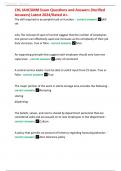Notes de cours
Theories of Marketing Summary 2023/2024 - UvA BA Master's
- Cours
- Établissement
Completed the course successfully on the first semester of academic year 2023/2024. Very up to date detailed notes that include all lectures, q&a's, and literature: articles. I also have a bundle with answers to reading questions & answers. Check it out and good luck :)
[Montrer plus]












